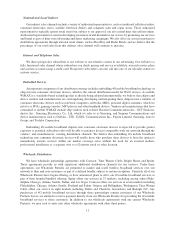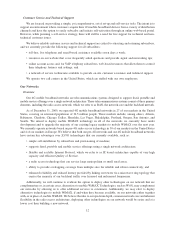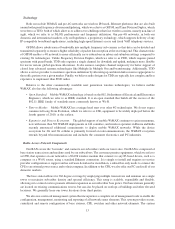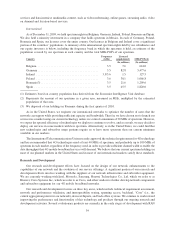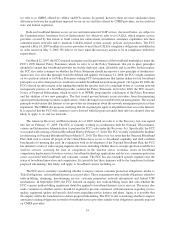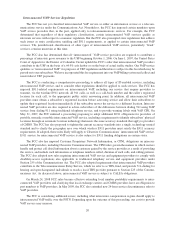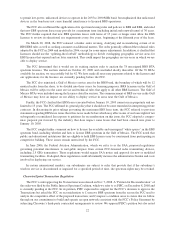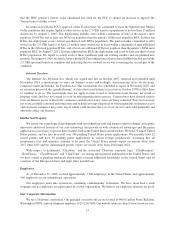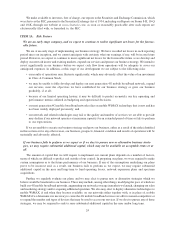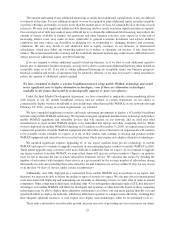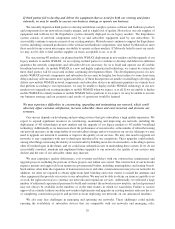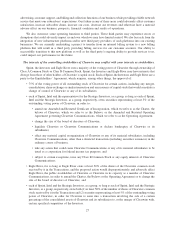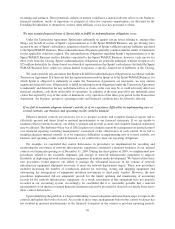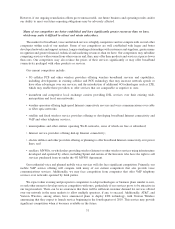Clearwire 2009 Annual Report Download - page 31
Download and view the complete annual report
Please find page 31 of the 2009 Clearwire annual report below. You can navigate through the pages in the report by either clicking on the pages listed below, or by using the keyword search tool below to find specific information within the annual report.R
egu
l
atory po
li
c
i
es app
li
ca
bl
eto
b
roa
db
an
d
Internet access, VoIP an
d
ot
h
er IP-serv
i
ces are cont
i
nu
i
ng t
o
develop, and it is possible that our broadband Internet access and VoIP services could be sub
j
ect to additiona
l
r
egulations in the future. Despite these recent regulatory mandates, both our Internet Phone Service and broadban
d
Internet access are su
bj
ect to many
f
ewer regu
l
at
i
ons t
h
an tra
di
t
i
ona
l
te
l
ep
h
one serv
i
ces. T
h
e extent o
f
t
h
e
r
e
g
ulations that will ultimatel
y
be applicable to these services and the impact of such re
g
ulations on the abilit
y
o
f
p
rov
id
ers to compete are current
l
yun
k
nown
.
S
p
ectrum Regu
l
atio
n
Th
e FCC rout
i
ne
ly
rev
i
ews
i
ts spectrum po
li
c
i
es an
d
ma
y
c
h
an
g
e
i
ts pos
i
t
i
on on spectrum a
ll
ocat
i
ons
f
ro
m
t
ime to time. On Jul
y
29, 2004, the FCC issued rules revisin
g
the band plan for BRS and EBS and establishin
g
more
flexible technical and service rules to facilitate wireless broadband operations in the 249
6
to 2
6
90 MHz band. The
F
CC a
d
opte
d
new ru
l
es t
h
at (1) expan
d
t
h
e perm
i
tte
d
uses o
f
EBS an
d
BRS spectrum to
f
ac
ili
tate t
h
e prov
i
s
i
on o
f
m
obile and fixed hi
g
h-speed data and voice services on channels previousl
y
used primaril
y
for one-wa
y
vide
o
d
e
li
very to
fi
xe
dl
ocat
i
ons; an
d
(2) c
h
ange some o
f
t
h
e
f
requenc
i
es on w
hi
c
h
BRS an
d
EBS operat
i
ons are
aut
h
or
i
ze
d
to ena
bl
e more e
ffi
c
i
ent operat
i
ons. T
h
ese new ru
l
es stream
li
ne
dli
cens
i
ng an
d
regu
l
atory
b
ur
d
en
s
associated with the prior service rules and created a “PCS-like” framework for
g
eo
g
raphic licensin
g
and inter
-
f
erence protect
i
on. Ex
i
st
i
ng
h
o
ld
ers o
f
BRS an
d
EBS
li
censes an
dl
eases genera
ll
y
h
ave exc
l
us
i
ve r
i
g
h
ts over use o
f
th
e
i
r ass
i
gne
df
requenc
i
es to prov
id
e commerc
i
a
l
w
i
re
l
ess
b
roa
db
an
d
serv
i
ces to res
id
ences,
b
us
i
nesses, e
d
uca
-
ti
ona
l
an
dg
overnmenta
l
ent
i
t
i
es w
i
t
hi
nt
h
e
i
r
g
eo
g
rap
hi
c mar
k
ets. T
h
ese ru
l
es a
l
so requ
i
re BRS
li
censees to
b
ear
t
heir own expenses in transitioning to the new band plan and, if they are seeking to initiate a transition, to pay th
e
c
osts of transitioning EBS licensees to the new band plan. The transition rules also provide a mechanism for
r
e
i
m
b
ursement o
f
transact
i
on costs
by
ot
h
er operators
i
nt
h
e mar
k
et. T
h
e FCC a
l
so expan
d
e
d
t
h
e scope o
fi
ts
s
pectrum leasin
g
rules and policies to allow BRS and EBS licensees to enter into flexible, lon
g
-term spectru
m
leases.
O
n April 21, 2006, the FCC issued an order adoptin
g
comprehensive rules for relocatin
g
incumbent BRS
o
p
erations in the 21
5
0 to 2162 MHz band. These rules will further facilitate the transition to the new 2.
5
GHz ban
d
pl
an. T
hi
sor
d
er
i
s current
l
ysu
bj
ect to Pet
i
t
i
ons
f
or Recons
id
erat
i
on an
dj
u
di
c
i
a
l
appea
l
.
O
n April 27, 2006, the FCC released a further order revisin
g
and clarif
y
in
g
its BRS/EBS rules. The FCC
genera
ll
y rea
ffi
rme
d
t
h
e
fl
ex
ibl
e tec
h
n
i
ca
l
an
d
operat
i
ona
l
ru
l
es on w
hi
c
h
our systems are
d
es
i
gne
d
an
d
operat
i
n
g
an
d
c
l
ar
ifi
e
d
t
h
e process o
f
trans
i
t
i
on
i
n
gf
rom t
h
eo
ld
spectrum p
l
an to t
h
e new spectrum p
l
an,
b
ut re
d
uce
d
t
h
e
t
ransition area from lar
g
e “ma
j
or economic areas,” to smaller, more mana
g
eable “basic tradin
g
areas.” Proponent
s
s
eeking to initiate a transition to the new band plan will be given a 30-month timeframe to notify the FCC of their
i
ntent to
i
n
i
t
i
ate a trans
i
t
i
on,
f
o
ll
owe
dby
at
h
ree-mont
h
p
l
ann
i
n
g
per
i
o
d
an
d
an 18-mont
h
trans
i
t
i
on comp
l
et
i
o
n
p
eriod. In markets where no proponent initiates a transition, licensees ma
y
self-transition to the new band plan. Th
e
F
CC adopted a procedure whereby the proponent will be reimbursed for the value it adds to a market through
r
e
i
m
b
ursement
by
ot
h
er commerc
i
a
l
operators
i
n a mar
k
et, on a pro-rata
b
as
i
s, a
f
ter t
h
e trans
i
t
i
on
i
s comp
l
ete
d
an
d
t
he FCC has been notified.
Th
e FCC a
l
so c
l
ar
ifi
e
d
t
h
e proce
d
ure
b
yw
hi
c
h
BRS an
d
EBS
li
censees must
d
emonstrate su
b
stant
i
a
l
serv
i
ce,
and required them to demonstrate substantial service b
y
Ma
y
1, 2011. Substantial service showin
g
s demonstrate t
o
t
he FCC that a licensee is not warehousin
g
spectrum. If a BRS or EBS licensee fails to demonstrate substantia
l
s
erv
i
ce
b
y May 1, 2011,
i
ts
li
cense may
b
e cance
l
e
d
an
d
ma
d
eava
il
a
bl
e
f
or re-
li
cens
i
ng. We are
i
nt
h
e process o
f
p
reparin
g
a plan to meet the substantial service deadline.
T
he FCC reaffirmed its decision to permit mobile satellite service providers to operate in the 2496 t
o
2
500 MHz band on a shared, co-primar
y
basis with BRS licensees. It also concluded that spectrum sharin
g
in th
e
2
496 to 2500 MHz band between BRS licensees and a limited number of incumbent licensees, such as broadcast
auxiliary service, fixed microwave and public safety licensees, is feasible. It declined to require the relocation of
t
hose incumbent licensees in the 24
9
6 to 2500 MHz band. The FCC reaffirmed its conclusion that BRS licensees
c
an share the 2496 to 2500 MHz band with industrial, scientific and medical devices because such devices t
y
picall
y
o
p
erate in a controlled environment and use fre
q
uencies closer to 24
5
0 MHz. The FCC also reaffirmed its decision
21


